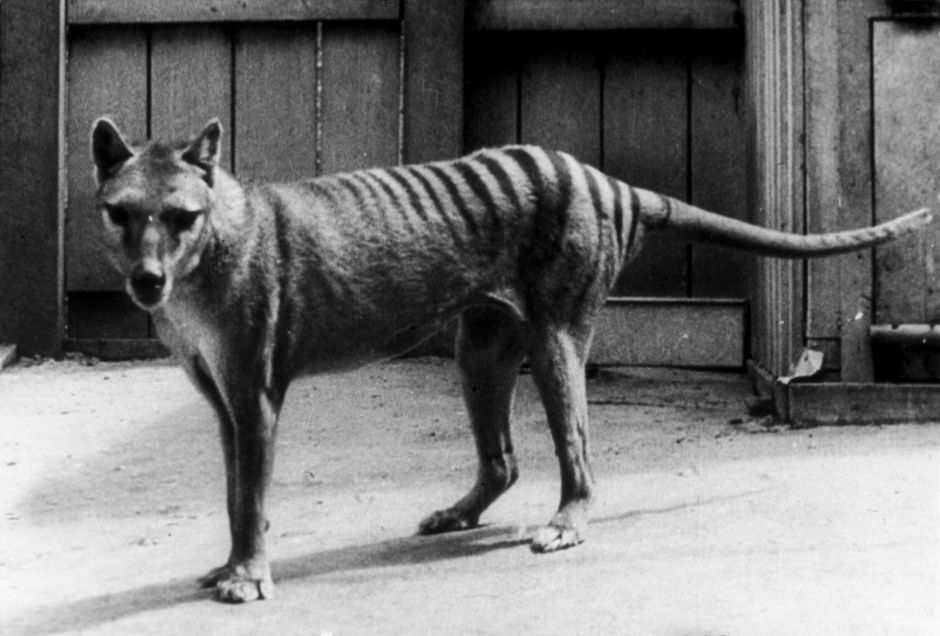Tasmanian wolf (4 photos)
What it looked like and why scientists want to bring it back to life in the next few years 
The last Tasmanian wolf to die at the zoo in 1936
The Tasmanian wolf is the largest marsupial predator. He was exterminated because, literally - "outwardly, the colonists did not like it." Scientists want bring him back to life, which could happen in the next few years
Everyone knows about the Tasmanian devil - a predatory marsupial, which is familiar to many from cartoons.
But few people know that he had a distant relative, an even larger marsupial - thylacine or Tasmanian wolf.
The thylacine resembled a large, short-haired dog with a hard tail like a kangaroo tail. An adult thylacine grew in length to 130 cm, plus a tail of about 60 cm. Adults weighed an average of 12 to 22 kg, the largest - up to 30 kg. 
The thylacine is also called the Tasmanian tiger because of the characteristic stripes on its back.
The animal appeared 2 million years ago. Initially, it was completely small and fed on insects. But then, given the scarcity of other predators, could breed in Australia, New Guinea and Tasmania. And began to increase in size.
They hunted mainly ground birds. Large birds were herded together, doing collective hunting. The animal ate a lot at once for the future - the stomach has been adapted for this. This compensated for the hungry times.
The thylacine was one of two marsupials that both had a pouch. sexes: another species is the water opossum from Central and South America. The sac of the thylacine male served as a protective sheath covering the external reproductive organs.
The Tasmanian wolf disappeared in stages. First disappeared in Australia. Here the reason is simple - lost in competition to wild dingo dogs, which Asian settlers brought here about 3,500 years ago. Still dingoes proved to be more effective hunters. And by the time you arrive Europeans dingoes ousted all predators from Australia, remaining the only ones.
But on the islands, including Tasmania, thylacine lived until the beginning of the 20th century.
The Tasmanian wolf led a midnight lifestyle and was quite shy, usually avoiding human contact.
His gait is extremely clumsy, so he could not run fast. But he could jump on two legs like a kangaroo.
The settlers began to lose their livestock. The reason for this was the feral dogs. But the locals made the thylacine the scapegoat because they did not like him and seemed hostile.
Already in 1830, a system of remuneration for extraction was created. thylacine, when the owners of the farms paid from the general fund for the brought skins. In 1888, the Tasmanian government also introduced a solid reward for their destruction.
The last known shooting of a wild thylacine occurred in 1930. 
Changing public opinion and initiating conservation action happened too late. The status of a protected species was granted in just 59 days before the death of Benjamin - the last known thylacine who died at the zoo in 1936.
There have been attempts to find the Tasmanian wolf in the wild, but all of them turned out to be unsuccessful. Since 1986, the animal has been officially considered extinct.
Colossal announced in August 2022 that it plans to "Give thylacine a second chance at life." One of the project investors Chris Hemsworth is the actor who played Thor. 
Bringing the Tasmanian wolf back to life is much easier than extinct prehistoric animal species. After all, he lived quite recently. And stayed its related species.
Colossal plans to essentially create a hybrid animal, with many of the characteristics of the Tasmanian wolf. Company scientists will use CRISPR gene editing technology to insert fragments of the restored thylacine DNA into the genome of the dasyurid family carnivorous marsupials such as the numbat and the Tasmanian devil, which are the closest relatives of an extinct animal.
Then the modified nucleus will be inserted into the egg of the dasurid, and when an embryo develops from it, it will be implanted by a surrogate mother.
You can see the full plan on their official website. Ben Lamm, founder of Colossal, predicts: “The expected period of pregnancy Tasmanian tiger up to 42 days. It may appear in the coming some years".





















